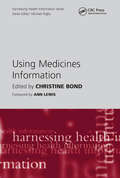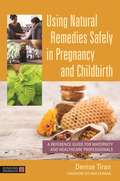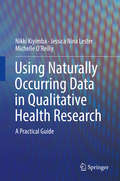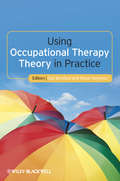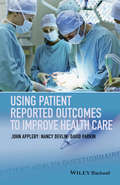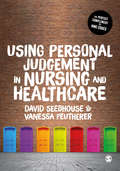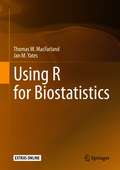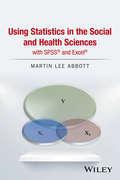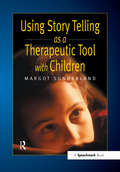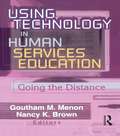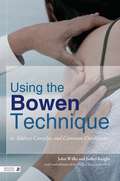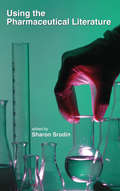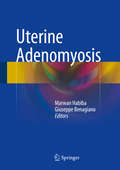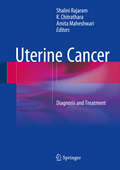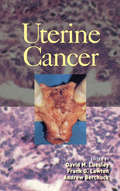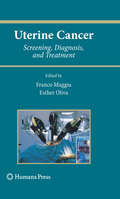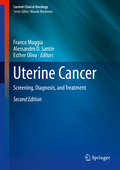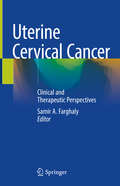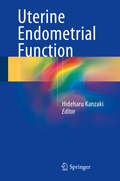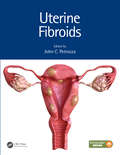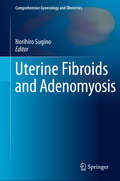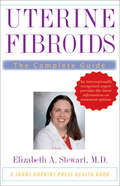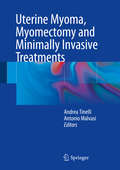- Table View
- List View
Using Medicines Information
by Christine BondThis CD-ROM contains the full text of "The Red Book" and "Making Sense of The Red Book". It includes NHS regulations, amendments to the statutory instruments, terms of service, pharmaceutical regulations, health service circulars, and the white paper "The New NHS: Modern, Dependable". There is also a special program called "The Red Book Expert", which works out the user's fees from basic information provided. Every reference is hyper-linked, and the user's own notes can be added, and are also fully searchable. This CD-ROM is licensed by the Department of Health.
Using Music in Child and Adolescent Psychotherapy (Creative Arts and Play Therapy)
by Laura E. Beer Jacqueline C. BirnbaumThere is growing evidence for the powerful role that music plays in enhancing children's cognitive, social, and emotional development. This is the first book to provide accessible ways for any mental health professional to integrate music into clinical work with children and adolescents. Rich case vignettes show how to use singing, drumming, listening to music, and many other strategies to connect with hard-to-reach children, promote self-regulation, and create opportunities for change. The book offers detailed guidelines for addressing different clinical challenges, including attachment difficulties, trauma, and behavioral, emotional, and communication problems. Each chapter concludes with concrete recommendations for practice; an appendix presents a photographic inventory of recommended instruments.
Using Natural Remedies Safely in Pregnancy and Childbirth: A Reference Guide for Maternity and Healthcare Professionals
by Denise TiranProviding in-depth information on natural remedies that midwives, doulas, GPs and other health professionals can use to advise and inform their clients, this reference guide focuses on safety in their application.The book brings together herbal medicine, homeopathy, essential oils, flower remedies and traditional remedies from other cultures, and applies them directly to pregnancy, childbirth and the postnatal period.Containing an alphabetical listing of 220 remedies covering common uses, contraindications and precautions, adverse effects and interactions, Using Natural Remedies Safely in Pregnancy and Childbirth is a vital resource for healthcare professionals working in conventional maternity care who wish to learn about the safe application of natural remedies.
Using Naturally Occurring Data in Qualitative Health Research: A Practical Guide
by Michelle O'Reilly Jessica Nina Lester Nikki KiyimbaThis highly practical resource brings new dimensions to the utility of qualitative data in health research by focusing on naturally occurring data. It examines how naturally occurring data complement interviews and other sources of researcher-generated health data, and takes readers through the steps of identifying, collecting, analyzing, and disseminating these findings in ethical research with real-world relevance. The authors acknowledge the critical importance of evidence-based practice in today’s healthcare landscape and argue for naturally occurring data as a form of practice-based evidence making valued contributions to the field. And chapters evaluate frequently overlooked avenues for naturally occurring data, including media and social media sources, health policy and forensic health contexts, and digital communications. Included in the coverage:· Exploring the benefits and limitations of using naturally occurring data in health research · Considering qualitative approaches that may benefit from using naturally occurring data · Utilizing computer-mediated communications and social media in health · Using naturally occurring data to research vulnerable groups · Reviewing empirical examples of health research using naturally occurring data Using Naturally Occurring Data in Qualitative Health Research makes concepts, methods, and rationales accessible and applicable for readers in the health and mental health fields, among them health administrators, professionals in research methodology, psychology researchers, and practicing and trainee clinicians.
Using Occupational Therapy Theory in Practice
by Alison Seymour Gail BonifaceCompetence in any profession depends upon an understanding of the theory that underlies it. This concise and practical text for students and practitioners bridges the gap between occupational therapy theory and clinical practice, offering highly practical advice on using theory in practice in a wide range of settings. It considers the nature of professional practice and the need for a sound theoretical basis from which to plan, implement and justify interventions, and investigates the practical use of occupational therapy theory and the issues such use raises in health and social care settings from a European perspective. Every occupational therapy student worldwide needs to know about the underlying theory of their profession and its application to practice. The book particularly debates the nature of the theory of occupational therapy via the introduction of the concept of models of the profession as an umbrella for practice, all of which is brought to life via case studies incorporating expert advice, reflection exercises and assessment and evaluation forms.
Using Patient Reported Outcomes to Improve Health Care
by John Appleby David Parkin Nancy DevlinA practical, introductory guide to the best use of Patient Reported Outcomes (PROs) to improve the quality of health care and patient health. Only title to exclusively introduce, explain and show how PROs can be best used to improve healthcare and patient outcomes Includes real life examples and case studies of PROs in practice Assesses the growing evidence base for PROs in practice Editor team from Office of Health Economics (OHE), The King's Fund and King's College London with contributions from practising clinicians, GPs and other healthcare professionals
Using Personal Judgement in Nursing and Healthcare
by Professor David Seedhouse Vanessa PeuthererWhat is personal judgement? How can it help me interpret and follow official guidelines? How can I use it successfully in my daily practice? Rules and codes for healthcare professionals continue to proliferate yet are unable to offer practical advice in specific circumstances. To help balance official rules with the variable, unique human element, David Seedhouse and Vanessa Peutherer explain what personal judgement is and how it can be applied routinely and effectively in everyday decision-making in healthcare. Through the use of over 40 interactive scenarios drawn from real-life practice, the authors encourage readers to use a range of techniques to boost their personal judgement, introducing 11 different models and approaches to decision-making and exploring their strengths as well as their limitations. The authors then talk through their own suggestions for solving commonplace but challenging healthcare problems. Timely, original and accessible, this book provides nurses and healthcare professionals with the tools needed to navigate the reality of everyday practice, while working with the many protocols they must consider and apply in both education and practice.
Using Personal Judgement in Nursing and Healthcare
by Professor David Seedhouse Vanessa PeuthererWhat is personal judgement? How can it help me interpret and follow official guidelines? How can I use it successfully in my daily practice? Rules and codes for healthcare professionals continue to proliferate yet are unable to offer practical advice in specific circumstances. To help balance official rules with the variable, unique human element, David Seedhouse and Vanessa Peutherer explain what personal judgement is and how it can be applied routinely and effectively in everyday decision-making in healthcare. Through the use of over 40 interactive scenarios drawn from real-life practice, the authors encourage readers to use a range of techniques to boost their personal judgement, introducing 11 different models and approaches to decision-making and exploring their strengths as well as their limitations. The authors then talk through their own suggestions for solving commonplace but challenging healthcare problems. Timely, original and accessible, this book provides nurses and healthcare professionals with the tools needed to navigate the reality of everyday practice, while working with the many protocols they must consider and apply in both education and practice.
Using R for Biostatistics
by Jan M. Yates Thomas W. MacFarlandThis book introduces the open source R software language that can be implemented in biostatistics for data organization, statistical analysis, and graphical presentation. In the years since the authors’ 2014 work Introduction to Data Analysis and Graphical Presentation in Biostatistics with R, the R user community has grown exponentially and the R language has increased in maturity and functionality. This updated volume expands upon skill-sets useful for students and practitioners in the biological sciences by describing how to work with data in an efficient manner, how to engage in meaningful statistical analyses from multiple perspectives, and how to generate high-quality graphics for professional publication of their research. A common theme for research in the diverse biological sciences is that decision-making depends on the empirical use of data. Beginning with a focus on data from a parametric perspective, the authors address topics such as Student t-Tests for independent samples and matched pairs; oneway and twoway analyses of variance; and correlation and linear regression. The authors also demonstrate the importance of a nonparametric perspective for quality assurance through chapters on the Mann-Whitney U Test, Wilcoxon Matched-Pairs Signed-Ranks test, Kruskal-Wallis H-Test for Oneway Analysis of Variance, and the Friedman Twoway Analysis of Variance. To address the element of data presentation, the book also provides an extensive review of the many graphical functions available with R. There are now perhaps more than 15,000 external packages available to the R community. The authors place special emphasis on graphics using the lattice package and the ggplot2 package, as well as less common, but equally useful, figures such as bean plots, strip charts, and violin plots. A robust package of supplementary material, as well as an introduction of the development of both R and the discipline of biostatistics, makes this ideal for novice learners as well as more experienced practitioners.
Using Statistics in the Social and Health Sciences with SPSS and Excel
by Martin Lee AbbottProvides a step-by-step approach to statistical procedures to analyze data and conduct research, with detailed sections in each chapter explaining SPSS® and Excel® applications This book identifies connections between statistical applications and research design using cases, examples, and discussion of specific topics from the social and health sciences. Researched and class-tested to ensure an accessible presentation, the book combines clear, step-by-step explanations for both the novice and professional alike to understand the fundamental statistical practices for organizing, analyzing, and drawing conclusions from research data in their field. The book begins with an introduction to descriptive and inferential statistics and then acquaints readers with important features of statistical applications (SPSS and Excel) that support statistical analysis and decision making. Subsequent chapters treat the procedures commonly employed when working with data across various fields of social science research. Individual chapters are devoted to specific statistical procedures, each ending with lab application exercises that pose research questions, examine the questions through their application in SPSS and Excel, and conclude with a brief research report that outlines key findings drawn from the results. Real-world examples and data from social and health sciences research are used throughout the book, allowing readers to reinforce their comprehension of the material. Using Statistics in the Social and Health Sciences with SPSS® and Excel® includes: * Use of straightforward procedures and examples that help students focus on understanding of analysis and interpretation of findings * Inclusion of a data lab section in each chapter that provides relevant, clear examples * Introduction to advanced statistical procedures in chapter sections (e.g., regression diagnostics) and separate chapters (e.g., multiple linear regression) for greater relevance to real-world research needs Emphasizing applied statistical analyses, this book can serve as the primary text in undergraduate and graduate university courses within departments of sociology, psychology, urban studies, health sciences, and public health, as well as other related departments. It will also be useful to statistics practitioners through extended sections using SPSS® and Excel® for analyzing data. Martin Lee Abbott, PhD, is Professor of Sociology at Seattle Pacific University, where he has served as Executive Director of the Washington School Research Center, an independent research and data analysis center funded by the Bill & Melinda Gates Foundation. Dr. Abbott has held positions in both academia and industry, focusing his consulting and teaching in the areas of statistical procedures, program evaluation, applied sociology, and research methods. He is the author of Understanding Educational Statistics Using Microsoft Excel® and SPSS®, The Program Evaluation Prism: Using Statistical Methods to Discover Patterns, and Understanding and Applying Research Design, also from Wiley.
Using Story Telling as a Therapeutic Tool with Children (Helping Children with Feelings)
by Margot SunderlandThis practical handbook begins with the philosophy and psychology underpinning the therapeutic value of story telling. It shows how to use story telling as a therapeutic tool with children and how to make an effective response when a child tells a story to you. It is an essential accompaniment to the "Helping Children with Feelings" series and covers issues such as: Why story telling is such a good way of helping children with their feelings? What resources you may need in a story-telling session? How to construct your own therapeutic story for a child? What to do when children tell stories to you? Things to do and say when working with a child's story.
Using Technology in Human Services Education: Going the Distance
by Goutham Menon Nancy K. BrownMake the most of what today&’s technology has to offer in human services education!Distance education presents special challenges to social work education. Using Technology in Human Services Education: Going the Distance provides case studies and practical research on making the best use of this powerful new tool for teaching. Designed for both practitioners and educators, this fascinating book examines the use of technology in education and practice in the field of social work and other human services. Because setting up distance-learning programs can be expensive, Using Technology in Human Services Education suggests ways to reduce the impact on the budget, including setting up a consortium to merge resources with other schools. It also shows how to integrate traditional instructional approaches with the new technologies, how to make use of email and electronic discussion groups, and how to use the Internet to hone practice-related skills. In addition, it covers the current status of the technology itself.Using Technology in Human Services Education: Going the Distance explores ways to maximize the potential of distance education, such as: a framework for designing distance education courses that fully utilize the unique environments these courses offer a discussion of the impact of technological tools in teaching specific course content ways that SACs (Site Advisory Committees) can increase students&’ socialization into their new professions ways that students need to be supported in order to feel a connection to a distance-learning program the use of GIS (Geographic Information Systems) to help meet and identify the information needs of a field placement agencyUsing Technology in Human Services Education offers creative approaches and practical advice for making the best use of the technology. Whatever your level of computer skill, from novice to hacker, this book will give you ideas you can use. No individual or institution interested in maintaining top quality in human services education should be without this book!
Using the Bowen Technique to Address Complex and Common Conditions
by Isobel Knight John WilksThe Bowen technique resets and repairs the body, restoring balance to relieve pain and improve energy. This book shows how it can be particularly effective at alleviating conditions that are renowned for being difficult to treat, as well as at enhancing performance in dance and other sports. Covering lower back pain, frozen shoulder, tennis elbow, carpal tunnel, hayfever, asthma, diabetes (type 2), migraines, stress and tension disorders, fibromyalgia, chronic fatigue, palliative care, performance enhancement, and in pre and post-natal care, clinical case studies reveal Bowen technique in action along with detailed explanations of how and why Bowen is so effective for each of these different situations. This is the perfect book for Bowen practitioners, and other complementary and alternative health practitioners and medical professionals wanting to know how and why the Bowen technique can help their patients, as well as patients interested in learning about what Bowen can do for them.
Using the Pharmaceutical Literature
by Sharon SrodinGathering information of critical importance for professionals in the pharmaceutical and medical device industries, this guide provides a comprehensive overview of key resources, such as databases, on-line directories, reports, and periodicals-providing at-a-glance guidance and collection development tools for information professionals in this fiel
Uterine Adenomyosis
by Marwan Habiba Giuseppe BenagianoRecent advances in imaging have renewed interest in uterine adenomyosis. The disease can now be diagnosed before hysterectomy which has advanced our understanding of its clinical impact, such as its effect on fertility. This book will provide an in-depth reference to recent scientific advances in the pathophysiology of uterine adenomyosis. It will represent some of the most up-to date and authoritative work in the field. This book is aimed at specialist clinicians and postgraduates wishing to acquire in-depth understanding of adenomyosis, and will be an essential reading for research scientists who will find a distillation of an up-to-date critical reading of literature.
Uterine Cancer
by Shalini Rajaram K. Chitrathara Amita MaheshwariUterine cancers are the commonest malignancies of the female genital tract in the developed world, and are increasing in numbers world over because of obesity and other life-style changes. Many of these malignancies are hereditary and thus, a better understanding of the genetic and molecular biology is needed. This would lead to appropriate treatment plan for improving the quality of life and long-term survival. This book addresses, in depth, all aspects of uterine malignancies covering both carcinomas and sarcomas. The book is divided into seven sections; the first two sections deal with epidemiology, molecular aspects, familial cancers and pathology and the later sections focus on diagnosis, imaging techniques and comprehensive management of both early stage and advanced cancers. Surgical techniques, adjuvant chemotherapy and radiotherapy have been covered in detail. Apart from the open surgical methods, role of laparoscopy and emerging role of robotic surgery in the contemporary management of endometrial cancers have been discussed. Written by authors with expertise in the field of gynecologic oncology from premier institutes, this book provides up-to-date information on best practice management of uterine malignancies.
Uterine Cancer
by David M. Luesley Andrew Berchuck Frank G. LawtonThis authoritative reference compiles the latest studies on the epidemiology, diagnosis, and treatment of uterine cancer and offers an extensive review of the molecular pathogenesis of endometrial and uterine disorders-analyzing patterns of disease presentation as population demographics change and considering the challenges this will place on future healthcare procedures.
Uterine Cancer
by Franco Muggia Esther OlivaThere are an estimated 41,000 new cases of Uterine and Endometrial Cancer each year in the United States alone, resulting in roughly 7300 deaths. In Uterine Cancer: Screening, Diagnosis and Treatment, Franco Muggia, Esther Oliva and a panel of prominent medical and gynecologic oncologists survey all aspects of Uterine and Endometrial Cancer, including current screening methods, staging and prognostic factors, and available treatment options. The discussion includes the role of imaging in the diagnosis and treatment of endometrial cancer, the molecular pathology and genetics of uterine cancer and the essential epidemiology of cancer of the endometrium. Authoritative and highly practical, Uterine Cancer: Screening, Diagnosis and Treatment is the definitive text on the most common cancer of the female genital tract, and a must-have for all gynecological residents and fellows, as well as gynecological oncologists and family practice doctors who wish to provide their patients with the best possible care.
Uterine Cancer: Screening, Diagnosis, and Treatment (Current Clinical Oncology)
by Franco Muggia Esther Oliva Alessandro D. SantinThere are more than 63,000 new cases of uterine and endometrial cancer each year in the United States, up from approximately 41,000 when the first edition of Uterine Cancer was published in 2009. A book focusing on these cancers was timely, with emergent sophistication in diagnosis increasingly impacting clinical decision-making. However, five years later, the need for an updated book on this topic is even stronger as oncologists recognize opportunities to impact the outcome on women that are increasingly diagnosed with these malignancies. Uterine Cancer: Screening, Diagnosis, and Treatment, Second Edition, part of the Current Clinical Oncology series, enhances the awareness on this somewhat neglected area of therapeutics, helping to integrate targeted therapies into the management of women with uterine cancer. Written by experts in the field in a highly practical and comprehensive manner, it is a must-have for all gynecological residents and fellows, as well as gynecological oncologists, medical oncologists, radiation oncologists, and family practice doctors who wish to provide their patients with the best possible care.
Uterine Cervical Cancer: Clinical and Therapeutic Perspectives
by Samir A. FarghalyThis volume provides a broad background of the basic sciences, clinical and therapeutic aspects, and management of uterine cervical cancer. It offers state-of-the-art information on the molecular genetics, biology, and clinical aspects of premalignant lesions of the uterine cervix, and provides a better understanding of the molecular and cellular events that underlie uterine cervical cancer. Uterine Cervical Cancer: Clinical and Therapeutic Perspectives contains extensive, updated information on the promising new developments in the diagnosis and management of uterine cervical cancer. It will serve as an invaluable resource for all clinicians and basic medical scientists caring for women with uterine cervical cancer, including attending surgeons, physicians, clinical fellows, and residents in the disciplines of gynecologic oncology, medical oncology, and surgical oncology.
Uterine Endometrial Function
by Hideharu KanzakiThis book focuses on uterine endometrial function and receptivity from multiple perspectives. The chapters cover a variety of topics including the role of estrogen and progesterone, animal models, parameters for assessing endometrial receptivity, the mechanism of angiogenesis, epigenetic regulation, and stem/progenitor cells. Despite nearly 35 years of experience with in vitro fertilization, the rate of successful implantations remains low. Abnormal endometrial receptivity has been proposed as one of the factors contributing to reduced reproductive potential in women, but our understanding of it is limited. Endometrial receptivity results from an orchestrated interplay between the embryo and the maternal endometrium, and the receptive status, known as the window of implantation, is reached only briefly in the mid-luteal phase. This book provides a comprehensive overview of the latest advances in endometrial function and paves the way for innovative treatments and drug development for infertility. This work will appeal to a wide readership, from researchers on endometrial function and assisted reproductive technology (ART) to clinicians and technicians in the field of gynecology.
Uterine Fibroids
by John C. PetrozzaUterine fibroids are a painful condition that may also create serious limitations on a patient's reproductive options. This new text from an acknowledged expert at a major regional referral center fully reviews the relevant diagnostic factors as well as the potential new medical treatments and current thinking about the various - sometimes controversial - surgical options available for management. Print versions of this book also include access to the eBook version with links to procedural videos.
Uterine Fibroids and Adenomyosis (Comprehensive Gynecology and Obstetrics)
by Norihiro SuginoThis volume elucidates state-of-the-art findings of uterine fibroids and adenomyosis, incorporating expert basic knowledge. Uterine fibroids and adenomyosis are common uterine tumors in reproductive-age women. However, the pathogenesis of the tumors is still poorly understood, and both genetic and environmental factors may be involved in their generation or development. Recent research on the genomics and molecular biology of uterine fibroids and adenomyosis has facilitated a better understanding of the pathogenesis and pathophysiology of these benign tumors. Renowned experts provide detailed discussions of basic research and clinical aspects of uterine fibroids and adenomyosis in this book, from histopathology and molecular pathogenesis to diagnosis and the latest treatment of uterine fibroids, including pregnancy complications of adenomyosis. A great deal of information and a deep understanding of molecular and genetic biology have led to development of more innovative treatments of these tumors. Thus this book benefits not only oncologists, seasoned gynecologists, and obstetricians, but also molecular biologists and other basic researchers who are involved in the treatment of uterine fibroids.
Uterine Fibroids: The Complete Guide (A Johns Hopkins Press Health Book)
by Elizabeth A. StewartProviding the most reliable and up-to-date information on this very common and difficult disorder, Dr. Stewart helps women understand uterine fibroids and make the best possible choices about their care.You've called in sick today. Your back and legs hurt. Your abdomen is bloated and more than a little uncomfortable. You are having your period, and the bleeding is so heavy you can't even think about leaving the house. You have uterine fibroids.One in every four women see their lives affected by uterine fibroids, which can cause heavy bleeding, abdominal bloating, pain, and infertility. The symptoms can be mildly annoying or life altering in severity. Until recently, hysterectomy was the only way to cure fibroids, and each year more than 200,000 hysterectomies are performed in the United States to treat these noncancerous growths. But hysterectomy isn’t always the best solution. The procedure can be devastating for women who were planning to get pregnant, and it is a significant surgery for anyone. In this comprehensive and compassionate guide, Dr. Elizabeth A. Stewart helps women understand the treatment options now available.An internationally recognized expert on fibroids, Dr. Stewart describes all the available medical and surgical treatments as well as alternative and complementary therapies. In addition to hysterectomy, she explains uterine artery embolization (UAE), noninvasive focused ultrasound (FUS), and innovative hormone treatments. Simple diagrams and photographs illustrate the condition—and its treatment. Dr. Stewart encourages women with fibroids to learn as much as they can before choosing a treatment plan. Providing the most reliable and up-to-date information on this very common and difficult disorder, she helps women understand uterine fibroids and make the best possible choices about their care.
Uterine Myoma, Myomectomy and Minimally Invasive Treatments
by Andrea Tinelli Antonio MalvasiUterine myomas are the most common benign tumors in women, affecting the half of women and mostly in reproductive age. Myomas cause significant morbidity and are the single most common indication for hysterectomy around the world. Thus, myomas represent a major personal and public health concern worldwide. The diagnosis of fibroids can be established based on ultrasound and radiological imaging. Recent research on the genomics and molecular biology of myomas has enabled us to better understand the pathogenesis and pathophysiology of this benign tumor, but more remains to be discovered. In the clinical parterre, novel methods of conservative treatments have been developed to allow many women to keep their reproductive capacity and to save uterus, and more novel treatments are available on the horizon. For this topic, an outstanding group of worldwide experts have come together to provide a detailed discussion of basic research and clinical aspects of myomas. All the existing knowledge will be summarized in this book that can serve as a starting point for clinicians, young doctors, students, fellows and all researchers who want to read up on this disease. This book is devoted to myomas, covering both recent advances in our understanding of their behaviour, and an overview of the current options for their minimally invasive treatments, with endoscopy and new devices. As we learn more about the molecular, genetic and biology of myomas, we will be able to develop more innovative treatments.
